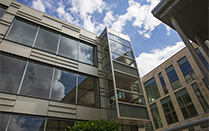
IMPROVING CAMPUS INFRASTRUCTURE
Some of the major improvements to infrastructure completed over the summer are very visible; others are not. Read in this issue about the many major projects completed by Physical Facilities and Information Technology Services, as well as the new programs offered by the University Center for Training and Development.
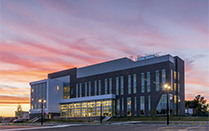
SCHOOL OF PHARMACY AND PHARMACEUTICAL SCIENCES OPENS NEW BUILDING
The opening of the new, $60-million School of Pharmacy and Pharmaceutical Sciences at the University's Health Sciences Campus in Johnson City, N.Y., headlines this quarterly report, but there's also good news about collaborations, external funding and student successes. Read more in this issue.
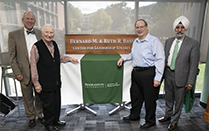
SUCCESSFUL INITIATIVES SUPPORT STUDENTS
It takes donors at many levels to make Binghamton University successful, and in this issue of the quarterly report, you can read about a number of them. Whether it's AVANGRID offering full-tuition scholarships and capstone project support, or playing golf to benefit the Alumni Legacy Scholarship, the Division of Advancement works with Binghamton supporters.
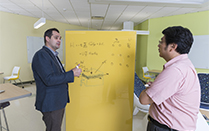
BINGHAMTON RESEARCH FUNDING SETS RECORD
Binghamton University reported research expenditures totaling $47.5 million in 2017-18, an increase of about 19 percent from the previous fiscal year. The figure tops 2011-12, the campus’ all-time best year for research funding, when just over $40 million was reported. The new record, which follows several years of steady growth, is an important sign of the campus’ creativity and innovation. Healthcare research accounted for nearly a third of expenditures, with electronics packaging and systems engineering following at about 22 percent.

BAXTER THE BEARCAT BOOSTS SCHOOL SPIRIT
The Division of Student Affairs spent the summer hosting students and families for orientation and preparing for the opening of the fall semester. With some new people on board and some others with new duties, it has been a busy time. Not too busy, though, to show Binghamton University pride, as you'll read about the new Baxter the Bearcat Bench in the University Union in this issue.
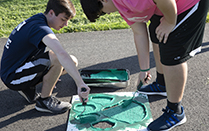
STUDENT-ATHLETES CONTINUE TO SUCCEED ACADEMICALLY
Student-athletes continue to shine on and off the courts and fields. The Athletics Department sets high academic standards, and student-athletes surpass them across the board. Read about the accomplishments made by student-athletes in their sports and in the classroom – and check out the videos showcasing fall sports and the new women's head basketball coach, Bethann Shapiro Ord, in this issue.
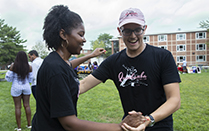
HELPING TO MAKE THE CAMPUS MORE INCLUSIVE
The Division of Diversity, Equity and Inclusion works to educate and empower everyone on campus in ways that create a welcoming community. From the Udiversity Educational Institute, that holds trainings for students, faculty and staff, to the Multicultural Resource Center and Q Center, the division's offices that work to build bridges and support students though education and events such as Sundaze, part of its Welcome Week programming. Read about the division's recent initiatives in this report.
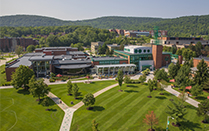
DONOR SUPPORT ADVANCES BINGHAMTON UNIVERSITY
The Binghamton University Foundation had a successful 2017-18 year, bringing in the second highest amount of cash ever in support of the University. Read the numbers in this issue of the quarterly report, and learn one way the Foundation celebrates its donors.
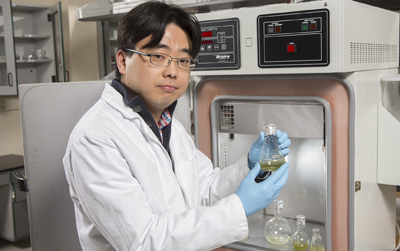
Engineer pursues biological solar power
A Binghamton University engineering researcher designed a biological solar cell that’s a million times more effective than current technology. Preliminary data on Seokheun “Sean” Choi’s next advancement is a thousand times better than that. His cell also works in the dark, and is self-sustaining.
The new designs don’t make biological solar cells practical, yet. But they do take them out of the realm of “absurd” and place them squarely in the realm of “someday soon.”
Here’s the challenge:
Current photovoltaic cells generate watts of energy per square centimeter. A solar chip about the size of your fingernail can power a simple handheld calculator. Existing biological cells — which use photosynthesis to generate electricity — produce picowatts per square centimeter — a trillionth of a watt. To power that same calculator, the cells would stretch 20 meters wide and from Binghamton to Ireland. Absurd.
Choi’s first biological solar cell produces a million times more energy, microwatts per square centimeter, so the calculator could operate with a solar panel that fits on a trailer home roof — just 20 meters by 5 meters. His findings were recently published in the Royal Society of Chemistry’s journal Lab on a Chip.
And Choi’s latest experiment churns out milliwatts per square centimeter — reducing the calculator’s solar panel to a backpack-sized 8 inches by 20.
That brings it into the range of practical application, says Hongseok “Moses” Noh, an engineer and professor at Drexel University who specializes in lab-on-a-chip technology and applications. “Milliwatt power should be sufficient to meet those needs,” Noh says. “But the device, so far, is too big for hand-held systems, honestly.”
If Choi can reduce the cell to a tenth of its size while maintaining milliwatt power density, it would be enough to power hand-held blood analysis devices or air-testing machines. “This is one of very few miniaturized bio-solar products,” Noh says, and it’s worth following Choi’s progress.
Read more about what makes Choi’s approach different in Discover-e.